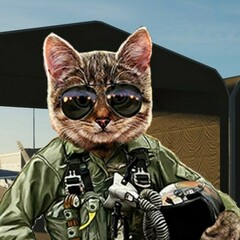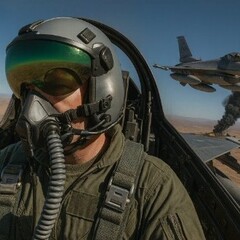All Activity
- Past hour
-

No stick displacement in Force feedback ?
Number481 replied to FZG_Immel's topic in Bugs and Problems
I can't say with certainty for the others you mentioned, but for the 190A8, P47 and Mosquito, elevator trim most certainly alters the center position of the FFB Spring effect. Take a look at the active spring effect on the configurator debug tab and you will see. Now, on the 190A8 specifically, it is not done very well. The elevator trim is quite sensitive in the aircraft itself, but the spring center point doesn't move very much at all. The result is that you still need to significantly manually alter the joystick position to counteract how fast the trim is moving, much like you would need to with a sprung joystick. If it were done "properly", you would simply hold the position of the stick and trim to relieve pressure. But there's not very much about the native DCS FFB implementation that is done 'properly'. -
I haven't really had a card longer then 2 or 3 years because it was always a significant bump up in fps and resolution (I have to agree on the marginal bump up from 3090 to 4090). I am now happy with the resolution and fps in DCS and Falcon BMS with my quest 3. If the 4090 is designed to last 8 years i also see no reason to go to a 5090. I also don't overclock and maybe use my pc on an average 5 hours a week.
-
Can't really make sense of that. Is the one you have on a disc or did you download it from their site? The current one is IL2 Battle of Stalingrad, with a whole bunch of DLCs that provide a lot of maps and planes (Moscow, Kuban, Normandy etc etc). They're all available on Steam too, though if you buy direct the devs get a lot more of the moolah.
-

waiting for resolution ED/RAZBAM Situation Info & Discussion
Baldrick33 replied to NineLine's topic in RAZBAM
I have a much more relaxed view based on the small number of occurrences over many years and see this is a an exceptional event. Compared with multiplayer titles that can die due to lack of participation or online racing titles where the car you have bought and want to race loses participation and simply becomes unavailable to race most of the time or simply ends then DCS module purchases seems a reasonably safe choice. There will always be an element of risk with any computer game purchases as to whether it will be supported long term. Unlike some others ED is privately owned and not at the behest of shareholders, parent companies or publishers. So the risk of the company being bought for its tech and changing direction to a more profitable arcade product seems negated. Of course there are third party relationships to consider but in comparison to many computer game studios the core development seems to have a more strategic long term. Having experienced the outcome of some of my favourite race and flight sim dev studios getting swallowed up by the big players I feel more confident ED will be producing stuff I want for the foreseeable future. -
Не сильно сложная миссия по уничтожению штаба противника в районе деревни. Установка: Распаковываем архив. В нем мы увидим папку "KA50" её нужно перенести в папку missions по пути "C:\Users\User\Saved Games\DCS\Missions\" Файл с миссией находится в "KA50\m2-Firesupport.miz" Приятных полётов! m2-ka50.zip
-
TheBiggerBass started following MPD size/location in [Alt]+F1 HUD only View
-
Not a bug but a request: is there any way of setting MPD size/location in [Alt]+F1 HUD View only? I know how to change general MPD size and location in monitor setup files, but I would like to have the additional MFD displays appear in [Alt]+F1 HUD View only. but not in F1 cockpit view. Thanks.
-
Ok, I have an IL 2 version... not played it for years! What version should I look for ?
-
I have answered all I can for now. The team are watching the feedback, again in the future maybe we can say more. All we can do is wait. thank you
-
paulos_muzza joined the community
-
-
Yes, DCS has been around 16 years and yes, it's still a very cool bit of software. However, I reckon this is a defining moment for ED. There's been controversy but this ones big, probably the biggest. I'm not questioning the current state of the modules. Like many, I'm foreseeing these modules being unusable in future versions of DCS as was the case with the Hawk and I'm asking what ED has in place to prevent this type of thing occurring with the remaining 3rd party devs. It's a pretty reasonable question. In terms of the EULA, the most relevant thing I can see says ED can simply walk away from any of it's obligations under the section I quote below: "9.1 Eagle Dynamics SA may transfer, assign, charge, sub-contract or otherwise dispose of this Licence, or any of our rights or obligations arising under it, at any time during the term of this Licence." It's not much of an agreement when one of the parties can just walk away from it's obligations and, as I say, EULA doesn't mean a company can ignore it's legal obligations set out by the nation it's trading in. Really, it's all meaningless. I highly doubt an individual is going to put all this to the test, it simply isn't worth the effort so we can forget all that nonsense. It boils down to this. I, and I suspect many others have lost or are losing confidence in the product because of this situation. If you can be bothered to have a look at my profile, you will see the sharp decline in purchases. This is almost entirely due to the situation with RAZBAM. It's not that I care about RAZBAM as such, it's that there's a lot of third party content, it's expensive and it's not beyond the realms of possibility that some of the smaller 3rd party devs could fall over for any number of reasons. I want to know what protections customers have should products stop working. What's the policy, if any? If there isn't one, maybe there should be. If it's just a matter of "read the EULA, this is what you signed up for" then ok, I guess we'll see how that works out long term.
-
I’d like to suggest an expansion to the current pilot profile system in DCS. Right now, the pilot profile does a good job of tracking stats like kills, flight time, and awarding virtual medals, ribbons, and badges. It’s a nice touch, but I think there’s potential to take it further and really enhance player immersion by shifting more focus to the pilot — not just the aircraft. What I’d Love to See: Customizable Pilot Avatars: Let us create and personalize our pilot with different gear, uniforms, helmet designs, etc. Walk-Around/Free Roam Mode: The ability to walk around our aircraft on the ramp, hangar, or airbase — even if it's limited to pre- and post-mission environments. Pilot Progression: Introduce a sense of progression — maybe a rank or leveling system tied to mission accomplishments, flight hours, or achievements. Unlockables: Achievements could unlock cosmetic items like custom patches, helmets, gloves, or callsigns that appear in briefings or cockpit decals. Increased Investment: These additions would help players feel more connected to their virtual persona — turning DCS into a more personal, lived-in experience, rather than just a series of disconnected aircraft operations. Why This Matters: Many of us love DCS not just for the flying, but for the fantasy of being a military pilot. By adding systems that reflect that identity, you give players more reason to keep flying, trying different missions, and investing time into the sim. Even for single-player users, this would add continuity and a deeper sense of “being there.” This wouldn’t need to interfere with the realism or sandbox nature of DCS — just give us a way to live in the world as a pilot, not just as a plane. Would love to hear what others think about this — and thanks for reading!
-
- pilot
- interaction
-
(and 1 more)
Tagged with:
-

vTF-77 Pilot & Controller Recruitment is OPEN.
vTF-77 Command replied to vTF-77 Command's topic in Jets Squadrons
F/A 18 - Hornet In the turbulent skies of the Cold War, where the specter of Soviet MiGs and missile batteries loomed large, the U.S. Navy faced a dilemma. Its carrier decks needed a versatile fighter—nimble enough to dogfight, rugged enough to strike ground targets, and compact enough to thrive in the cramped, salty world of naval aviation. The answer was the F/A-18 Hornet, a twin-engine marvel that would carve its legend as a workhorse of the skies, blending grit, precision, and adaptability across decades of conflict. This is its story. Genesis in Crisis The tale begins in the early 1970s, when the Navy’s aging F-4 Phantoms and A-7 Corsairs struggled to keep pace with emerging threats. The F-14 Tomcat, while a formidable interceptor, was costly and specialized. The Navy wanted a multirole fighter—capable of air-to-air combat and ground attack—that wouldn’t break the bank. Meanwhile, the Air Force was testing lightweight fighters in a competition that pitted General Dynamics’ YF-16 against Northrop’s YF-17 Cobra. The YF-16 won for the Air Force, but the Navy saw potential in the YF-17’s twin-engine design, ideal for carrier operations where redundancy meant survival. Northrop teamed with McDonnell Douglas to scale up the YF-17 into a naval beast. The result was the F/A-18 Hornet, named for its aggressive sting and versatility. By 1978, the first prototype took flight, a sleek, 40-foot-long jet with a 56-foot wingspan, powered by two General Electric F404 turbofans pumping 17,700 pounds of thrust each. It could hit Mach 1.8, climb to 50,000 feet, and carry 13,700 pounds of weapons, from AIM-9 Sidewinders to AGM-65 Mavericks. Its fly-by-wire controls and heads-up display made it a pilot’s dream, while strengthened landing gear and a tailhook endured the brutal slams of carrier decks. Early Days and Growing Pains The F/A-18A entered service with the Navy and Marine Corps in 1983, replacing A-7s and supplementing F-14s. Early Hornets weren’t flawless. The A and B models (single- and two-seat variants) had a shorter range—about 400 nautical miles—than desired, and their radar, the APG-65, lagged behind the F-15’s. Pilots grumbled about the cockpit’s cramped ergonomics. Yet, the Hornet’s agility shone. It could turn on a dime, and its multirole DNA let it switch from bombing runs to dogfights mid-mission. By 1985, squadrons like VFA-25 were deploying on carriers like USS Constellation, ready to face Soviet Backfires or Middle Eastern threats. The Hornet’s first combat came in 1986 during Operation El Dorado Canyon. F/A-18s from USS Coral Sea escorted Navy strikes on Libyan targets, fending off MiG-23s and SAMs. No kills, but the jet proved it could handle hot zones. The real test was the 1991 Gulf War. Hornets flew thousands of sorties, dropping GBU-12s on Iraqi tanks and engaging MiGs with AIM-7 Sparrows. On January 17, 1991, a VFA-81 Hornet piloted by Lt. Cmdr. Mark Fox shot down an Iraqi MiG-21 while simultaneously bombing an airfield—a multirole masterclass. Over 30,000 sorties later, the Hornet’s reliability and 90% mission success rate silenced critics Evolution of a Legend The Hornet grew sharper with time. The F/A-18C and D models (1987) brought night-attack capabilities, upgraded APG-73 radar, and compatibility with AGM-88 HARMs and JDAMs. Cockpit displays modernized, and range stretched to 500 nautical miles with external tanks. In the 1990s, Hornets patrolled Iraq’s no-fly zones, struck Serbian targets in Bosnia and Kosovo, and pounded Taliban caves in Afghanistan. Their precision made them ideal for urban strikes, minimizing civilian losses. By 2001, a new Hornet emerged: the F/A-18E/F Super Hornet. Bigger, brawnier, and born from budget battles that killed pricier programs, the Super Hornet was a 25% larger airframe with 35% more thrust, a 600-mile range, and 11 weapon stations. Its APG-79 AESA radar could track 20 targets at once, and stealthy design tweaks reduced its radar signature. Entering service in 2001, the E (single-seat) and F (two-seat) models became the Navy’s backbone, phasing out F-14s by 2006. The EA-18G Growler, a 2009 variant, turned the Super Hornet into an electronic warfare beast, jamming enemy radars with ALQ-218 pods. Challenges and Legacy The Hornet isn’t invincible. Its range limits carrier standoff distance against China’s DF-21D missiles. The F-35C, with stealth and sensor fusion, overshadows it. Maintenance hogs 20-30 hours per flight hour, and crashes—like 14 between 2015-2020—highlight risks of aging airframes. Yet, at $60 million per Super Hornet versus $110 million for an F-35C, it’s a budget-friendly warrior. The F/A-18’s story is one of a scrappy underdog rising to greatness. From a YF-17 reject to a carrier king, it’s flown 10 million hours, dropped 100,000 bombs, and downed enemy jets while jamming their radars. It’s the jet that does it all—dogfighter, bomber, jammer, lifeline for troops below. As it nears retirement, the Hornet’s legacy soars: a relentless, adaptable predator that ruled the skies and seas, stinging hard until the end. Come fly the hornet! Apply info on the website https://www.vtf77.com/?utm_source=discord&utm_medium=social&utm_campaign=DCSF- 10 replies
-
- navy flight ops
- air force
- (and 11 more)
-
F/A 18 - Hornet In the turbulent skies of the Cold War, where the specter of Soviet MiGs and missile batteries loomed large, the U.S. Navy faced a dilemma. Its carrier decks needed a versatile fighter—nimble enough to dogfight, rugged enough to strike ground targets, and compact enough to thrive in the cramped, salty world of naval aviation. The answer was the F/A-18 Hornet, a twin-engine marvel that would carve its legend as a workhorse of the skies, blending grit, precision, and adaptability across decades of conflict. This is its story. Genesis in Crisis The tale begins in the early 1970s, when the Navy’s aging F-4 Phantoms and A-7 Corsairs struggled to keep pace with emerging threats. The F-14 Tomcat, while a formidable interceptor, was costly and specialized. The Navy wanted a multirole fighter—capable of air-to-air combat and ground attack—that wouldn’t break the bank. Meanwhile, the Air Force was testing lightweight fighters in a competition that pitted General Dynamics’ YF-16 against Northrop’s YF-17 Cobra. The YF-16 won for the Air Force, but the Navy saw potential in the YF-17’s twin-engine design, ideal for carrier operations where redundancy meant survival. Northrop teamed with McDonnell Douglas to scale up the YF-17 into a naval beast. The result was the F/A-18 Hornet, named for its aggressive sting and versatility. By 1978, the first prototype took flight, a sleek, 40-foot-long jet with a 56-foot wingspan, powered by two General Electric F404 turbofans pumping 17,700 pounds of thrust each. It could hit Mach 1.8, climb to 50,000 feet, and carry 13,700 pounds of weapons, from AIM-9 Sidewinders to AGM-65 Mavericks. Its fly-by-wire controls and heads-up display made it a pilot’s dream, while strengthened landing gear and a tailhook endured the brutal slams of carrier decks. Early Days and Growing Pains The F/A-18A entered service with the Navy and Marine Corps in 1983, replacing A-7s and supplementing F-14s. Early Hornets weren’t flawless. The A and B models (single- and two-seat variants) had a shorter range—about 400 nautical miles—than desired, and their radar, the APG-65, lagged behind the F-15’s. Pilots grumbled about the cockpit’s cramped ergonomics. Yet, the Hornet’s agility shone. It could turn on a dime, and its multirole DNA let it switch from bombing runs to dogfights mid-mission. By 1985, squadrons like VFA-25 were deploying on carriers like USS Constellation, ready to face Soviet Backfires or Middle Eastern threats. The Hornet’s first combat came in 1986 during Operation El Dorado Canyon. F/A-18s from USS Coral Sea escorted Navy strikes on Libyan targets, fending off MiG-23s and SAMs. No kills, but the jet proved it could handle hot zones. The real test was the 1991 Gulf War. Hornets flew thousands of sorties, dropping GBU-12s on Iraqi tanks and engaging MiGs with AIM-7 Sparrows. On January 17, 1991, a VFA-81 Hornet piloted by Lt. Cmdr. Mark Fox shot down an Iraqi MiG-21 while simultaneously bombing an airfield—a multirole masterclass. Over 30,000 sorties later, the Hornet’s reliability and 90% mission success rate silenced critics Evolution of a Legend The Hornet grew sharper with time. The F/A-18C and D models (1987) brought night-attack capabilities, upgraded APG-73 radar, and compatibility with AGM-88 HARMs and JDAMs. Cockpit displays modernized, and range stretched to 500 nautical miles with external tanks. In the 1990s, Hornets patrolled Iraq’s no-fly zones, struck Serbian targets in Bosnia and Kosovo, and pounded Taliban caves in Afghanistan. Their precision made them ideal for urban strikes, minimizing civilian losses. By 2001, a new Hornet emerged: the F/A-18E/F Super Hornet. Bigger, brawnier, and born from budget battles that killed pricier programs, the Super Hornet was a 25% larger airframe with 35% more thrust, a 600-mile range, and 11 weapon stations. Its APG-79 AESA radar could track 20 targets at once, and stealthy design tweaks reduced its radar signature. Entering service in 2001, the E (single-seat) and F (two-seat) models became the Navy’s backbone, phasing out F-14s by 2006. The EA-18G Growler, a 2009 variant, turned the Super Hornet into an electronic warfare beast, jamming enemy radars with ALQ-218 pods. Challenges and Legacy The Hornet isn’t invincible. Its range limits carrier standoff distance against China’s DF-21D missiles. The F-35C, with stealth and sensor fusion, overshadows it. Maintenance hogs 20-30 hours per flight hour, and crashes—like 14 between 2015-2020—highlight risks of aging airframes. Yet, at $60 million per Super Hornet versus $110 million for an F-35C, it’s a budget-friendly warrior. The F/A-18’s story is one of a scrappy underdog rising to greatness. From a YF-17 reject to a carrier king, it’s flown 10 million hours, dropped 100,000 bombs, and downed enemy jets while jamming their radars. It’s the jet that does it all—dogfighter, bomber, jammer, lifeline for troops below. As it nears retirement, the Hornet’s legacy soars: a relentless, adaptable predator that ruled the skies and seas, stinging hard until the end. Come fly the hornet! Apply info on the website https://www.vtf77.com/?utm_source=discord&utm_medium=social&utm_campaign=DCSF
-
F/A 18 - Hornet In the turbulent skies of the Cold War, where the specter of Soviet MiGs and missile batteries loomed large, the U.S. Navy faced a dilemma. Its carrier decks needed a versatile fighter—nimble enough to dogfight, rugged enough to strike ground targets, and compact enough to thrive in the cramped, salty world of naval aviation. The answer was the F/A-18 Hornet, a twin-engine marvel that would carve its legend as a workhorse of the skies, blending grit, precision, and adaptability across decades of conflict. This is its story. Genesis in Crisis The tale begins in the early 1970s, when the Navy’s aging F-4 Phantoms and A-7 Corsairs struggled to keep pace with emerging threats. The F-14 Tomcat, while a formidable interceptor, was costly and specialized. The Navy wanted a multirole fighter—capable of air-to-air combat and ground attack—that wouldn’t break the bank. Meanwhile, the Air Force was testing lightweight fighters in a competition that pitted General Dynamics’ YF-16 against Northrop’s YF-17 Cobra. The YF-16 won for the Air Force, but the Navy saw potential in the YF-17’s twin-engine design, ideal for carrier operations where redundancy meant survival. Northrop teamed with McDonnell Douglas to scale up the YF-17 into a naval beast. The result was the F/A-18 Hornet, named for its aggressive sting and versatility. By 1978, the first prototype took flight, a sleek, 40-foot-long jet with a 56-foot wingspan, powered by two General Electric F404 turbofans pumping 17,700 pounds of thrust each. It could hit Mach 1.8, climb to 50,000 feet, and carry 13,700 pounds of weapons, from AIM-9 Sidewinders to AGM-65 Mavericks. Its fly-by-wire controls and heads-up display made it a pilot’s dream, while strengthened landing gear and a tailhook endured the brutal slams of carrier decks. Early Days and Growing Pains The F/A-18A entered service with the Navy and Marine Corps in 1983, replacing A-7s and supplementing F-14s. Early Hornets weren’t flawless. The A and B models (single- and two-seat variants) had a shorter range—about 400 nautical miles—than desired, and their radar, the APG-65, lagged behind the F-15’s. Pilots grumbled about the cockpit’s cramped ergonomics. Yet, the Hornet’s agility shone. It could turn on a dime, and its multirole DNA let it switch from bombing runs to dogfights mid-mission. By 1985, squadrons like VFA-25 were deploying on carriers like USS Constellation, ready to face Soviet Backfires or Middle Eastern threats. The Hornet’s first combat came in 1986 during Operation El Dorado Canyon. F/A-18s from USS Coral Sea escorted Navy strikes on Libyan targets, fending off MiG-23s and SAMs. No kills, but the jet proved it could handle hot zones. The real test was the 1991 Gulf War. Hornets flew thousands of sorties, dropping GBU-12s on Iraqi tanks and engaging MiGs with AIM-7 Sparrows. On January 17, 1991, a VFA-81 Hornet piloted by Lt. Cmdr. Mark Fox shot down an Iraqi MiG-21 while simultaneously bombing an airfield—a multirole masterclass. Over 30,000 sorties later, the Hornet’s reliability and 90% mission success rate silenced critics Evolution of a Legend The Hornet grew sharper with time. The F/A-18C and D models (1987) brought night-attack capabilities, upgraded APG-73 radar, and compatibility with AGM-88 HARMs and JDAMs. Cockpit displays modernized, and range stretched to 500 nautical miles with external tanks. In the 1990s, Hornets patrolled Iraq’s no-fly zones, struck Serbian targets in Bosnia and Kosovo, and pounded Taliban caves in Afghanistan. Their precision made them ideal for urban strikes, minimizing civilian losses. By 2001, a new Hornet emerged: the F/A-18E/F Super Hornet. Bigger, brawnier, and born from budget battles that killed pricier programs, the Super Hornet was a 25% larger airframe with 35% more thrust, a 600-mile range, and 11 weapon stations. Its APG-79 AESA radar could track 20 targets at once, and stealthy design tweaks reduced its radar signature. Entering service in 2001, the E (single-seat) and F (two-seat) models became the Navy’s backbone, phasing out F-14s by 2006. The EA-18G Growler, a 2009 variant, turned the Super Hornet into an electronic warfare beast, jamming enemy radars with ALQ-218 pods. Challenges and Legacy The Hornet isn’t invincible. Its range limits carrier standoff distance against China’s DF-21D missiles. The F-35C, with stealth and sensor fusion, overshadows it. Maintenance hogs 20-30 hours per flight hour, and crashes—like 14 between 2015-2020—highlight risks of aging airframes. Yet, at $60 million per Super Hornet versus $110 million for an F-35C, it’s a budget-friendly warrior. The F/A-18’s story is one of a scrappy underdog rising to greatness. From a YF-17 reject to a carrier king, it’s flown 10 million hours, dropped 100,000 bombs, and downed enemy jets while jamming their radars. It’s the jet that does it all—dogfighter, bomber, jammer, lifeline for troops below. As it nears retirement, the Hornet’s legacy soars: a relentless, adaptable predator that ruled the skies and seas, stinging hard until the end. Come fly the hornet! Apply info on the website https://www.vtf77.com/?utm_source=discord&utm_medium=social&utm_campaign=DCSF
-

vTF-77 Pilot recruitment OPEN
vTF-77 Command replied to vTF-77 Command's topic in Squadron Recruiting
F/A 18 - Hornet In the turbulent skies of the Cold War, where the specter of Soviet MiGs and missile batteries loomed large, the U.S. Navy faced a dilemma. Its carrier decks needed a versatile fighter—nimble enough to dogfight, rugged enough to strike ground targets, and compact enough to thrive in the cramped, salty world of naval aviation. The answer was the F/A-18 Hornet, a twin-engine marvel that would carve its legend as a workhorse of the skies, blending grit, precision, and adaptability across decades of conflict. This is its story. Genesis in Crisis The tale begins in the early 1970s, when the Navy’s aging F-4 Phantoms and A-7 Corsairs struggled to keep pace with emerging threats. The F-14 Tomcat, while a formidable interceptor, was costly and specialized. The Navy wanted a multirole fighter—capable of air-to-air combat and ground attack—that wouldn’t break the bank. Meanwhile, the Air Force was testing lightweight fighters in a competition that pitted General Dynamics’ YF-16 against Northrop’s YF-17 Cobra. The YF-16 won for the Air Force, but the Navy saw potential in the YF-17’s twin-engine design, ideal for carrier operations where redundancy meant survival. Northrop teamed with McDonnell Douglas to scale up the YF-17 into a naval beast. The result was the F/A-18 Hornet, named for its aggressive sting and versatility. By 1978, the first prototype took flight, a sleek, 40-foot-long jet with a 56-foot wingspan, powered by two General Electric F404 turbofans pumping 17,700 pounds of thrust each. It could hit Mach 1.8, climb to 50,000 feet, and carry 13,700 pounds of weapons, from AIM-9 Sidewinders to AGM-65 Mavericks. Its fly-by-wire controls and heads-up display made it a pilot’s dream, while strengthened landing gear and a tailhook endured the brutal slams of carrier decks. Early Days and Growing Pains The F/A-18A entered service with the Navy and Marine Corps in 1983, replacing A-7s and supplementing F-14s. Early Hornets weren’t flawless. The A and B models (single- and two-seat variants) had a shorter range—about 400 nautical miles—than desired, and their radar, the APG-65, lagged behind the F-15’s. Pilots grumbled about the cockpit’s cramped ergonomics. Yet, the Hornet’s agility shone. It could turn on a dime, and its multirole DNA let it switch from bombing runs to dogfights mid-mission. By 1985, squadrons like VFA-25 were deploying on carriers like USS Constellation, ready to face Soviet Backfires or Middle Eastern threats. The Hornet’s first combat came in 1986 during Operation El Dorado Canyon. F/A-18s from USS Coral Sea escorted Navy strikes on Libyan targets, fending off MiG-23s and SAMs. No kills, but the jet proved it could handle hot zones. The real test was the 1991 Gulf War. Hornets flew thousands of sorties, dropping GBU-12s on Iraqi tanks and engaging MiGs with AIM-7 Sparrows. On January 17, 1991, a VFA-81 Hornet piloted by Lt. Cmdr. Mark Fox shot down an Iraqi MiG-21 while simultaneously bombing an airfield—a multirole masterclass. Over 30,000 sorties later, the Hornet’s reliability and 90% mission success rate silenced critics Evolution of a Legend The Hornet grew sharper with time. The F/A-18C and D models (1987) brought night-attack capabilities, upgraded APG-73 radar, and compatibility with AGM-88 HARMs and JDAMs. Cockpit displays modernized, and range stretched to 500 nautical miles with external tanks. In the 1990s, Hornets patrolled Iraq’s no-fly zones, struck Serbian targets in Bosnia and Kosovo, and pounded Taliban caves in Afghanistan. Their precision made them ideal for urban strikes, minimizing civilian losses. By 2001, a new Hornet emerged: the F/A-18E/F Super Hornet. Bigger, brawnier, and born from budget battles that killed pricier programs, the Super Hornet was a 25% larger airframe with 35% more thrust, a 600-mile range, and 11 weapon stations. Its APG-79 AESA radar could track 20 targets at once, and stealthy design tweaks reduced its radar signature. Entering service in 2001, the E (single-seat) and F (two-seat) models became the Navy’s backbone, phasing out F-14s by 2006. The EA-18G Growler, a 2009 variant, turned the Super Hornet into an electronic warfare beast, jamming enemy radars with ALQ-218 pods. Challenges and Legacy The Hornet isn’t invincible. Its range limits carrier standoff distance against China’s DF-21D missiles. The F-35C, with stealth and sensor fusion, overshadows it. Maintenance hogs 20-30 hours per flight hour, and crashes—like 14 between 2015-2020—highlight risks of aging airframes. Yet, at $60 million per Super Hornet versus $110 million for an F-35C, it’s a budget-friendly warrior. The F/A-18’s story is one of a scrappy underdog rising to greatness. From a YF-17 reject to a carrier king, it’s flown 10 million hours, dropped 100,000 bombs, and downed enemy jets while jamming their radars. It’s the jet that does it all—dogfighter, bomber, jammer, lifeline for troops below. As it nears retirement, the Hornet’s legacy soars: a relentless, adaptable predator that ruled the skies and seas, stinging hard until the end. Come fly the hornet! Apply info on the website https://www.vtf77.com/?utm_source=discord&utm_medium=social&utm_campaign=DCSF- 9 replies
-
- navy flight ops
- air force
- (and 7 more)
-
Auch in dem Video ist das Bild verhältnismäßig scharf. Scheint also ein individuelles Problem zu sein und einfach meiner Unfähigkeit geschuldet, zumindest habe ich nach langer Recherche niemanden gefunden (ausser Cupra), der das gleiche Problem hat. Macht aber nix, ich warte mal auf den nächsten Patch. Aber vielen Dank für Eure Hilfe!
-

FPV Quadcopter Drone [v0.9.0 beta]
Tanuki44 replied to nibbylot's topic in Flyable/Drivable Mods for DCS World
This is one of the known issues -
ED has stated that the FF F-15C will be strictly an Air to Air platform only and that it will not carry any A-G munitions, so unfortunately this is not happening.
-
It's called "Digital Combat Simulator" but that doesn't mean you have to fly combat all the time. The quality of the planes and maps allows not only for great combat flights, but just flights period. It's a sandbox after all, it's what you make of it. And I make a lot of great non-combat flights. For my part, I'm here first and foremost for the flying. And DCS, certainly for me, has the best flightsim characteristics of them all. For sure I'm gonna blow **** up, but that's secondary to the quality of the flying. If it was just about the "pew pew" I'd be over with the Blore Blunder crowd flying from an exterior view. Barf! But that's not my thing. DCS gives me the tighest rightest flgithsim and the ability to blow **** up. My choice. And my choice regarding the C-130, is a great big "Yes please!"
-
Maybe for the future it would be a solution to mark 3rd Party products with a lable, like "Source Code Secured" or something like that. Making it obvious for any customer if a product will be supported even in case a developer shuts down its business or leaves his modules abandoned. That could be a sales booster for such modules and an inducement for developers to accept contracts which force them to give the source code to ED, when publishing a module. The big problem I have is not, that there is a dispute between ED and Razbam, since things can happen and we don´t know who ist right or wrong. My problem is that I can not tell if something like this happens to any other of my beloved modules. I woul´d be very dissapointed, if the Strike Eagle stops working but when something like this heapens to my Phantom I would go crazy. There are several modules upcomming I am interrested in like Thyphoon or Tornado but the situation leaves me with a bad feeling about purchasing them.
-
speed-of-heat started following Buy a 5090?
-
if the 4090 works for you and DCS is your primary game / you don't care about the features of 5x series card ... just hang on to your 4090... i have a 1080ti that is still running from the factory (now in my daughters PC) but and i don't expect that my 4090 will have a much shorter life than that, which is what 8 years on or so ... when i moved from a 3090 to a 4090 i wanted the extra FPS for VR and i did sell that at the time ... but i was unhappy with the performance ... for DCS in VR.
-
?? As already stated, the Huey and Hip are very widely used transport helicopters, the Chinook is in ELS and we do have the free mod for the UH60. Like any aircraft type in DCS, I'm sure that we'd all like more, but that takes time. We do also have the script mods for both CTLD and CSAR. I personally embed them into ALL of my missions with helicopters in them. Could they be better? Yes, absolutely. The CSAR mod requires a shot down pilot (which can also be scripted), but wouldn't it be nice if we could spawn a downed airman without needing to shoot something down. Additionally, CSAR cannot be conducted over water, as pilots ejecting over water simply drown. I'd love to see them using life vests, life rafts and having homing beacons. For WW2 scenarios, I'd like to be able to direct rescue boats for downed pilots. So yes, CSAR can be improved, but for me, I see the key "opportunities" existing with the logic of how to conduct CSAR.
-
I understand, but we can not talk about specifics of different contracts. If that changes in the future we will let you know.
- Today
-
Madman10 joined the community
-
It only affects the resolution of the monitor. My understanding is that reducing the resolution has such minimal benefits that it's not even recommended.
-
Have you tried putting in setting for the AI aircraft of "afterburners" - disable? If not, give it a go. Apparently, the AI Warbird pilots can and will happily use WEP, and don't have the same time limits that we as pilots do. The "afterburners" setting, when disabled with a warbird, now prevents AI using WEP all the time.















